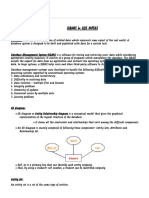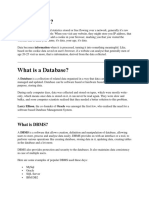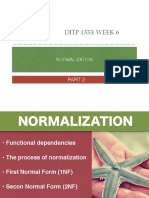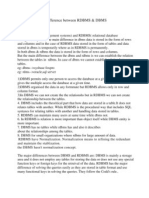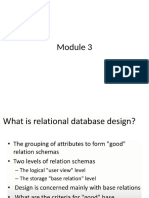0 ratings0% found this document useful (0 votes)
50 viewsUnit 3 Normalization
Unit 3 Normalization
Uploaded by
Sourav mukhopadhyayNormalization is a database design technique that organizes tables to reduce redundancy and dependency of data. It divides large tables into smaller tables and links them using relationships to reduce anomalies from data modifications. The goal of normalization is to reduce data redundancy and improve data integrity through structuring data into tables without duplicating or losing information.
Copyright:
© All Rights Reserved
Available Formats
Download as PPT, PDF, TXT or read online from Scribd
Unit 3 Normalization
Unit 3 Normalization
Uploaded by
Sourav mukhopadhyay0 ratings0% found this document useful (0 votes)
50 views157 pagesNormalization is a database design technique that organizes tables to reduce redundancy and dependency of data. It divides large tables into smaller tables and links them using relationships to reduce anomalies from data modifications. The goal of normalization is to reduce data redundancy and improve data integrity through structuring data into tables without duplicating or losing information.
Original Title
Unit 3 Normalization.ppt
Copyright
© © All Rights Reserved
Available Formats
PPT, PDF, TXT or read online from Scribd
Share this document
Did you find this document useful?
Is this content inappropriate?
Normalization is a database design technique that organizes tables to reduce redundancy and dependency of data. It divides large tables into smaller tables and links them using relationships to reduce anomalies from data modifications. The goal of normalization is to reduce data redundancy and improve data integrity through structuring data into tables without duplicating or losing information.
Copyright:
© All Rights Reserved
Available Formats
Download as PPT, PDF, TXT or read online from Scribd
Download as ppt, pdf, or txt
0 ratings0% found this document useful (0 votes)
50 views157 pagesUnit 3 Normalization
Unit 3 Normalization
Uploaded by
Sourav mukhopadhyayNormalization is a database design technique that organizes tables to reduce redundancy and dependency of data. It divides large tables into smaller tables and links them using relationships to reduce anomalies from data modifications. The goal of normalization is to reduce data redundancy and improve data integrity through structuring data into tables without duplicating or losing information.
Copyright:
© All Rights Reserved
Available Formats
Download as PPT, PDF, TXT or read online from Scribd
Download as ppt, pdf, or txt
You are on page 1of 157
Normalization is a database design technique
which organizes tables in a manner that
reduces redundancy and dependency of data.
It divides larger tables to smaller tables and
links them using relationships.
During modification if any of the row missed
out if any of the data would not get updated
It will lead to inconsistent data hence data
redundancy also leads to inconsistency in
data, as a result of updation anomaly.
Functional dependency
Fully functional dependency
Partial dependency
Transitive dependency
Multi-valued dependency
Trivial functional dependency
Non-Trivial functional dependency
Lossy decomposition
Non-Lossy decomposition(Lossless)
In simple words Normalization is a systematic way of
ensuring that a database structure is suitable for general-
purpose querying and free of certain undesirable
characteristics—insertion, update, and deletion anomalies—
that could lead to a loss of data integrity.
the goal of data normalization is to reduce data redundancy,
an important consideration for application developers
because it is incredibly difficult to stores objects in a
relational database that maintains the same information in
several places.
Database normalization is the process of
restructuring a relational database in
accordance with a series of so-called
normal forms in order to reduce data
redundancy and improve data integrity.
Normalization is conceptually cleaner and
easier to maintain and change as your needs
change.
ALL other attributes depends upon student_id
or subject_id except total_marks,total_marks
depends upon exam_name which is not a part
of primary key.
When there is an attribute in a table which
depends on some non-prime attribute and
not on prime attribute ,which is termed as
Transitive dependency.
AS total_marks depends upon exam_name
which is a non-prime attribute.
How to make the table satisfy BCNF?
Not used practically.
A relation is in 5 NF if it is in 4NF and not having
any join dependency and joining is lossless.
Join dependency exists if we decompose a
relation R into R1, R2--- Rn and later on if we try
to join R1, R2---Rn back in any order, we will not
be able to get the exact R relation.
Lossless means there should be no loss of tuples
and there should be no extra tuples also.
You might also like
- Client Server Architecture A Complete Guide - 2020 EditionFrom EverandClient Server Architecture A Complete Guide - 2020 EditionNo ratings yet
- UNIT I To III Database and Data ProcessingDocument43 pagesUNIT I To III Database and Data ProcessingAnjali MahajanNo ratings yet
- DBMS Unit-IDocument172 pagesDBMS Unit-IIdlNo ratings yet
- Fingerprint Recognition Using MatlabDocument22 pagesFingerprint Recognition Using MatlabAbhishek De100% (1)
- VbscriptexamplesDocument76 pagesVbscriptexamplesBalu KcbNo ratings yet
- DBMS NormalizationDocument53 pagesDBMS NormalizationTulipNo ratings yet
- Chapter 1 - Computer Network OverviewDocument36 pagesChapter 1 - Computer Network OverviewGENENE TISENo ratings yet
- Project Synopsis On LAN ConnectionDocument15 pagesProject Synopsis On LAN ConnectionডৰাজবংশীNo ratings yet
- QTP Scripts For Flight ReservationDocument16 pagesQTP Scripts For Flight ReservationRamu PalankiNo ratings yet
- Network Analysis Using Wireshark Cookbook: Chapter No. 13 "Troubleshooting Bandwidth and Delay Problems"Document22 pagesNetwork Analysis Using Wireshark Cookbook: Chapter No. 13 "Troubleshooting Bandwidth and Delay Problems"Packt PublishingNo ratings yet
- CNS Lab ManualDocument41 pagesCNS Lab Manualsaraswathi deviNo ratings yet
- Distributed System Course FileDocument26 pagesDistributed System Course Filesreekanth naraNo ratings yet
- Android Based Course Learning Materials Application For Computer Science Students85bc40vwd6Document10 pagesAndroid Based Course Learning Materials Application For Computer Science Students85bc40vwd6olami lekanNo ratings yet
- Mobile Transport LayerDocument18 pagesMobile Transport LayervalansterNo ratings yet
- DBMS NotesDocument20 pagesDBMS NotesSHUVO 777No ratings yet
- Chapter 10: Forouzan Data Communications and NetworksDocument3 pagesChapter 10: Forouzan Data Communications and NetworksMaithaNo ratings yet
- Instructor Guide For IntroductionDocument174 pagesInstructor Guide For IntroductionNIRANJANNo ratings yet
- Explain ISO - OSI, Seven Layer Network Architecture Giving The Functions of Each LayerDocument1 pageExplain ISO - OSI, Seven Layer Network Architecture Giving The Functions of Each LayerAbdulhaq SadiqiNo ratings yet
- Cohesion MetricsDocument17 pagesCohesion MetricsManju SrinivasanNo ratings yet
- DIP IPT Unit V CompleteDocument69 pagesDIP IPT Unit V CompleteankurwidguNo ratings yet
- Viva QuestionsDocument2 pagesViva QuestionsDarwinNo ratings yet
- CCNA 3 Final Exam Answers (2012)Document27 pagesCCNA 3 Final Exam Answers (2012)Juan Diego Arellano VitelaNo ratings yet
- 10ec71 NotesDocument129 pages10ec71 NotesMSAMHOURINo ratings yet
- Unit - 1 Architecture of Distributed SystemsDocument22 pagesUnit - 1 Architecture of Distributed SystemsAnjna SharmaNo ratings yet
- Dcap107 Dcap404 Object Oriented Programming PDFDocument329 pagesDcap107 Dcap404 Object Oriented Programming PDFnaZarNo ratings yet
- Communication: Distributed Systems Principles and ParadigmsDocument43 pagesCommunication: Distributed Systems Principles and Paradigmsabu syedNo ratings yet
- CN NotesDocument109 pagesCN Notesanujgargeya27No ratings yet
- M.SC., - CS & IT - 2011-12Document33 pagesM.SC., - CS & IT - 2011-12Mathan NaganNo ratings yet
- CC4E - C Programming For EverybodyDocument1 pageCC4E - C Programming For EverybodyOwen PerrinNo ratings yet
- Switching: Dr. Gihan NaguibDocument24 pagesSwitching: Dr. Gihan NaguibvrkatevarapuNo ratings yet
- 4.2.4.5 Packet Tracer - Connecting A Wired and Wireless LAN Instructions (Editado)Document5 pages4.2.4.5 Packet Tracer - Connecting A Wired and Wireless LAN Instructions (Editado)Benjamin GmNo ratings yet
- Data Communication Assignment Final PDFDocument5 pagesData Communication Assignment Final PDFFahad RuhulNo ratings yet
- Vtu Computer Network Lab ManualDocument61 pagesVtu Computer Network Lab ManualMayank Kushal100% (1)
- Database Recovery TechniquesDocument41 pagesDatabase Recovery TechniquesShahidUmarNo ratings yet
- Bluetooth Wifi Wimax LTE SCGDocument57 pagesBluetooth Wifi Wimax LTE SCGRama KrishnaNo ratings yet
- Practical 4Document8 pagesPractical 4MS GauharNo ratings yet
- Z TransformDocument111 pagesZ Transformvikramviv80% (5)
- Assembler Design OptionsDocument19 pagesAssembler Design OptionsShantheri Bhat100% (2)
- Switching TechniquesDocument8 pagesSwitching Techniquesnak patNo ratings yet
- AN1630 - High Performance Communication NetworksDocument17 pagesAN1630 - High Performance Communication NetworksPavithra SunNo ratings yet
- Scripting QTP - Ch09 - WSHDocument73 pagesScripting QTP - Ch09 - WSHKrishnakant UdavantNo ratings yet
- Theoretical and Practical Analysis On CNN, MTCNN and Caps-Net Base Face Recognition and Detection PDFDocument35 pagesTheoretical and Practical Analysis On CNN, MTCNN and Caps-Net Base Face Recognition and Detection PDFDarshan ShahNo ratings yet
- A Model For Network SecurityDocument1 pageA Model For Network SecurityMukul SoniNo ratings yet
- Wallace Tree Multiplier Part1Document5 pagesWallace Tree Multiplier Part1vineeth_vs_4No ratings yet
- Distributed System Lab ManualDocument62 pagesDistributed System Lab ManualIrfaan Khan Qasmi75% (4)
- CS6551 CN NotesDocument216 pagesCS6551 CN NotesPapithaNo ratings yet
- ACID Properties of TransactionsDocument13 pagesACID Properties of TransactionsSwati PqrNo ratings yet
- DIGITAL ASSIGNMENT 3 ELA WiresharkDocument5 pagesDIGITAL ASSIGNMENT 3 ELA WiresharkPraneel Mishra 18BIT0426No ratings yet
- Image Processing and Machine VisionDocument2 pagesImage Processing and Machine VisionNaveenKumarLNo ratings yet
- Module-1 PPT Data CommunicationDocument168 pagesModule-1 PPT Data CommunicationShruthi D100% (1)
- Tools Machine LearningDocument9 pagesTools Machine LearningMaria LavanyaNo ratings yet
- GSM Operations, Administration, and MaintenanceDocument17 pagesGSM Operations, Administration, and MaintenanceLenin. S.B100% (1)
- SAD 03 Object Oriented ConceptsDocument41 pagesSAD 03 Object Oriented ConceptsNooh NiaziNo ratings yet
- A Probabilistic Theory of Deep Learning: Unit 2Document17 pagesA Probabilistic Theory of Deep Learning: Unit 2HarshitNo ratings yet
- Computers Network NotesDocument224 pagesComputers Network NotesAnkur AhireNo ratings yet
- Software Analysis An Design ToolsDocument13 pagesSoftware Analysis An Design Toolsvepowo LandryNo ratings yet
- Cloud Based Blood Bank System - G83Document18 pagesCloud Based Blood Bank System - G83Kunal GadeNo ratings yet
- Network Management System A Complete Guide - 2020 EditionFrom EverandNetwork Management System A Complete Guide - 2020 EditionRating: 5 out of 5 stars5/5 (1)
- Database Management System Technologies A Complete Guide - 2019 EditionFrom EverandDatabase Management System Technologies A Complete Guide - 2019 EditionRating: 5 out of 5 stars5/5 (1)
- Unit 3 NormalizationDocument157 pagesUnit 3 NormalizationNikhil Kumar Agarwal KNo ratings yet
- Tenis Academy Management SYSTEM (Sourav Summer Traing)Document18 pagesTenis Academy Management SYSTEM (Sourav Summer Traing)Sourav mukhopadhyayNo ratings yet
- Unit 5 - Mec 135 TheoryDocument24 pagesUnit 5 - Mec 135 TheorySourav mukhopadhyay100% (2)
- Unit 4 Transaction ProcessingDocument45 pagesUnit 4 Transaction ProcessingSourav mukhopadhyayNo ratings yet
- Project 1Document1 pageProject 1Sourav mukhopadhyayNo ratings yet
- New Doc 2019-06-29 09.06.58Document11 pagesNew Doc 2019-06-29 09.06.58Sourav mukhopadhyayNo ratings yet
- Thank You For E-Ticketing. Wishes You A Pleasant Journey and Hopes To Serve You Again in FutureDocument1 pageThank You For E-Ticketing. Wishes You A Pleasant Journey and Hopes To Serve You Again in FutureSourav mukhopadhyayNo ratings yet
- Normalization in DBMS11Document12 pagesNormalization in DBMS11Kasthoori Kunthi VenkatramananNo ratings yet
- Micro Project Report: (Your Guide Name)Document16 pagesMicro Project Report: (Your Guide Name)Anand 28No ratings yet
- DBMSDocument60 pagesDBMSHarshit gehlotNo ratings yet
- DBMS ER ModelDocument89 pagesDBMS ER ModelTulipNo ratings yet
- Database Management Systems IIDocument41 pagesDatabase Management Systems IISahan Harinda NagodawithanaNo ratings yet
- DBMS Solutions For EndSemDocument54 pagesDBMS Solutions For EndSemVivek KumarNo ratings yet
- Lecture Week 6 - StudentDocument26 pagesLecture Week 6 - Studentmma mixed sportsNo ratings yet
- 10.3 Normal Forms Based On Primary Keys: Chapter 10-1Document64 pages10.3 Normal Forms Based On Primary Keys: Chapter 10-1sambashivarao100% (2)
- Rel Alg Tutorial 3Document3 pagesRel Alg Tutorial 3shiva darshanNo ratings yet
- NormalizationDocument45 pagesNormalizationkarthikjespNo ratings yet
- Difference Between RDBMS & DBMSDocument2 pagesDifference Between RDBMS & DBMSrkjrocksNo ratings yet
- 4.4 NormalizationDocument55 pages4.4 NormalizationHayredin MussaNo ratings yet
- Database ResearchDocument41 pagesDatabase ResearchFrancis ReyesNo ratings yet
- DBMS Module-IVDocument9 pagesDBMS Module-IVSivaNo ratings yet
- DBMS 3.1Document82 pagesDBMS 3.1Advaith HindalahallyNo ratings yet
- 18CSC303J DBMS Sample MCQDocument12 pages18CSC303J DBMS Sample MCQK MAHESHWARI (RA1811031010041)No ratings yet
- What Is NormalizationDocument24 pagesWhat Is NormalizationAditya BeheraNo ratings yet
- DBMS - NotesDocument101 pagesDBMS - NotesPravallika KotteNo ratings yet
- Normalisation QuestionsDocument1 pageNormalisation QuestionsA ChakrabartiNo ratings yet
- Detailed Syllabus of Database Management System For GateDocument4 pagesDetailed Syllabus of Database Management System For GateAniruddha DubeyNo ratings yet
- CP 224 LECT - 2 - Relational Database DesignDocument32 pagesCP 224 LECT - 2 - Relational Database DesignDitielo LemunstoneNo ratings yet
- Data Management (Assignment 1)Document5 pagesData Management (Assignment 1)Carlos SamNo ratings yet
- NormalizationDocument30 pagesNormalizationabenezer g/kirstosNo ratings yet
- BCS-15 Relational Model IIIDocument12 pagesBCS-15 Relational Model IIIViswashNo ratings yet
- DBMS Ga 2Document4 pagesDBMS Ga 2pushkar.23182016No ratings yet
- Database Design: Belgium Campus - DBD2x1 - Lesson 19Document7 pagesDatabase Design: Belgium Campus - DBD2x1 - Lesson 19EnricoNo ratings yet
- Unit 3Document23 pagesUnit 3Karthikeyan RamajayamNo ratings yet
- NormalizationDocument101 pagesNormalizationPrit PatelNo ratings yet
- NormalizationDocument46 pagesNormalizationLakmal KarunarathnaNo ratings yet
- Rdbms Model Question PaperDocument1 pageRdbms Model Question PaperKannan ThenmozhiNo ratings yet














